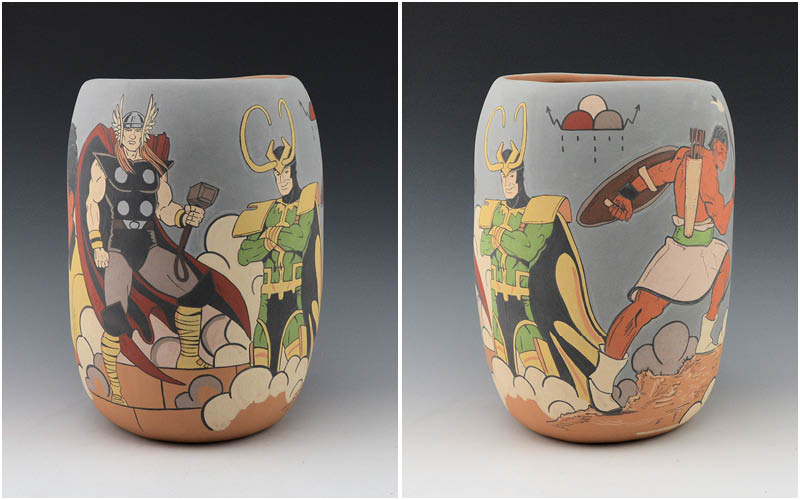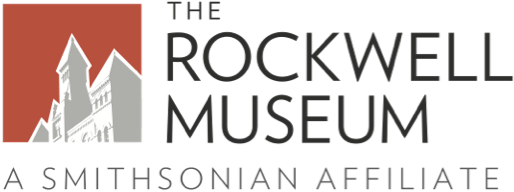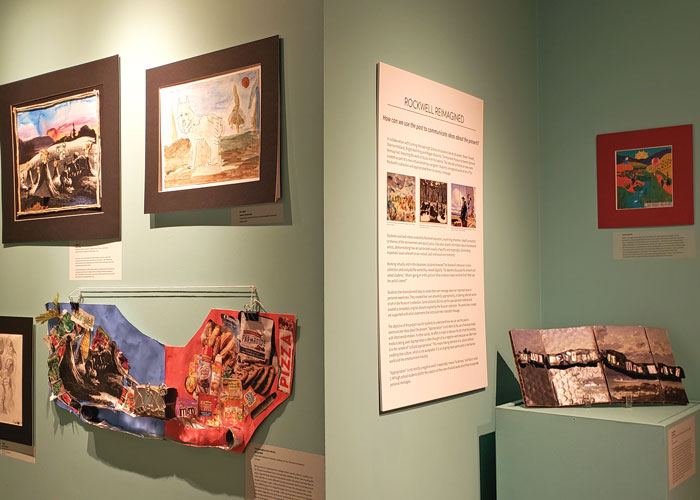How can we use the past to communicate ideas about the present? That’s the question students in Studio in Art B were asked for this special student exhibition that explores appropriation and activism in art.
In collaboration with art teachers Wendy Brubaker, Shawn Farwell, Sharron Holland, Birgitt Wolf-King and Megan Wukovitz at the Corning-Painted High School, The Rockwell Museum presents Rockwell Reimagined, now on view in the Museum’s Student Gallery (Floor 2). The selected artworks were created as part of a new virtual school tour program. Students reimagined works of art in The Rockwell’s collection and appropriated them to convey a message. This exhibition is on view now through June 1, 2021.
To begin, students watched videos created by Rockwell educators, examining artworks in-depth connected to themes of the environment and social justice. Educators shared information about the featured artists, demonstrating how art can be both visually impactful and meaningful, illuminating important issues relevant to our natural, built and social environments.
How do artists illuminate important issues about our environment?
Students learned about native Cochiti Pueblo artist, Virgil Ortiz with educator, Amy Ruza at The Rockwell and examined his sculpture, Ancient Elder in the Museum’s collection. In addition, the video incorporates a public art mural, Visibility of Truth, that was created and painted in collaboration with Virgil Ortiz in 2016 in the Corning community. Watch the video to explore how Virgil Ortiz uses his creativity to imagine a world in a futuristic dimension grounded in history and cultural events, and how he brings attention to the relationship between people and their surrounding environments.
How do artists bring our awareness to issues of social justice?
In this video, students explored how sometimes it isn’t what an artist shows us – but what they omit, and leave out, that communicates a message. Rockwell educator Kate Swanson uses one work from artist Kara Walker’s Emancipation Approximation series to explore this concept. Walker is known for her controversial silhouette imagery that neither denounces nor affirms racial stereotypes, leaving the viewer to fill in the blanks with existing biases.
Working virtually and in the classroom, students browsed The Rockwell’s eMuseum and analyzed the works they viewed digitally. The teachers discussed the artwork and asked students:
- What’s going on in this picture?
- What evidence makes me think that?
- What was the artist’s intent?”
Students then brainstormed ideas to create their own message about an important issue or personal experience. They created their own artwork by appropriating, or altering, a selected work of art in the Museum’s collection. Some students did not use the appropriation method, instead creating an entirely new artwork inspired by the Museum’s collection. The works they created are supported with artist statements that articulate their intended message.
The objective of the project was for students to understand how we can use the past to communicate ideas about the present. “Appropriation” in art refers to the use of existing media with little transformation; in other words, no effort is made to obscure the fact that the existing media is being used. Appropriation is often thought of as a negative word because we often hear it in the context of “cultural appropriation”. This means taking elements of a culture without crediting that culture, which is not acceptable! It is an ongoing issue particularly in the fashion world and the entertainment industry.
“Appropriation” is not strictly a negative word. It essentially means “to borrow”, and that is what C-PP high school students did for the creation of their one-of-a-kind works of art on view that incorporate personal messages. Here is an example of how artist, Jason Garcia / Okuu Pin appropriates marvel cinema characters in his ceramic sculpture, Pueblo Warriors Jar in The Rockwell’s collection.

Consider these points and questions as you analyze Pueblo Warriors Jar:
- What do you see in this image? What’s going on in this artwork?
- Marvel comic books and the Avengers that we know and love reached reservations in the 1960s and 1970s, 50 to60 years ago. At that time, many people did not have TVs, and there was no internet! Comic books were an exciting source of entertainment.
- The comics resonated with young Native Americans on the reservation, especially in Pueblo communities, because of a long history of storytelling.
- Pueblo Warriors Jar appropriates comic book iconography to depict historic Pueblo warriors.
- This jar features Marvel’s Thor and Loki characters alongside historical heroes from Garcia’s Tewa Tales of Suspense comic-inspired series of screenprints and clay tiles.
Studio in Art is an introductory level art course offered at the high school for Grades 9 and 10. The initial purpose of this program was to spark excitement about art! Rockwell educators aimed to inspire students to create art at home or in the classroom in response to themes presented in the artwork. The goal was to connect students to artwork at The Rockwell and to foster an appreciation for art and culture. As students grow and mature into young adults, the hope is that they continue to stay engaged with museums of all disciplines and seek out cultural experiences as they navigate their futures.




